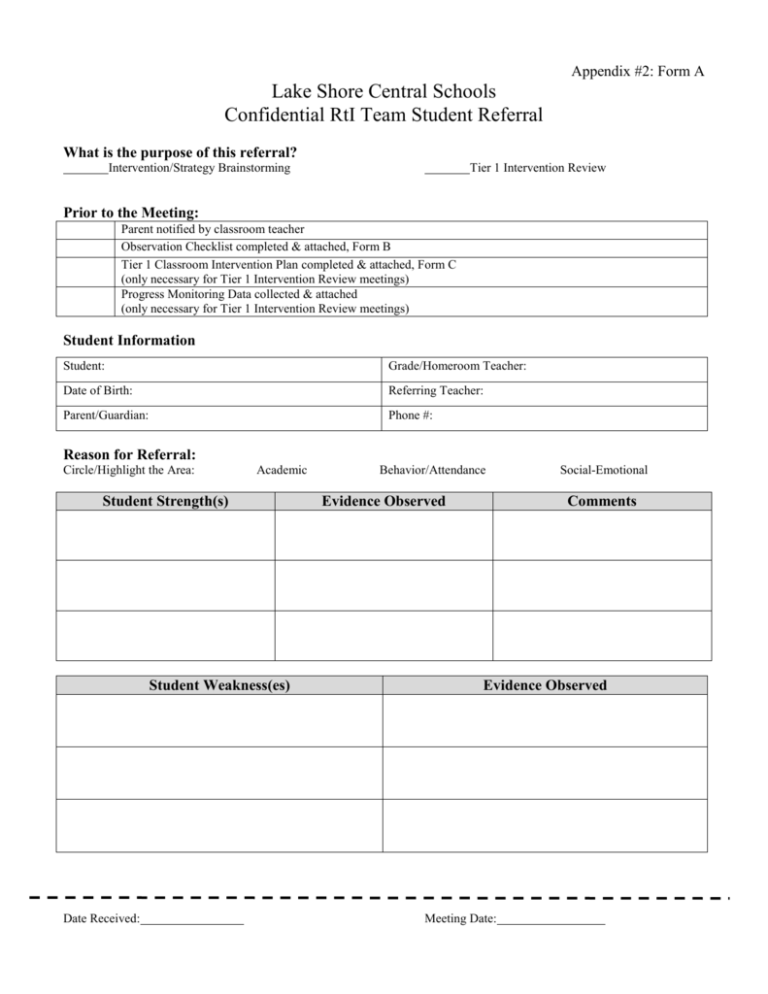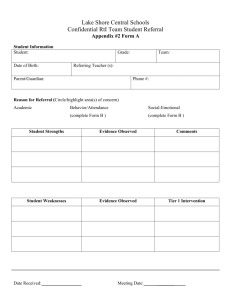RtI K-5: Student Referral Forms (ABC)
advertisement

Appendix #2: Form A Lake Shore Central Schools Confidential RtI Team Student Referral What is the purpose of this referral? Intervention/Strategy Brainstorming Tier 1 Intervention Review Prior to the Meeting: Parent notified by classroom teacher Observation Checklist completed & attached, Form B Tier 1 Classroom Intervention Plan completed & attached, Form C (only necessary for Tier 1 Intervention Review meetings) Progress Monitoring Data collected & attached (only necessary for Tier 1 Intervention Review meetings) Student Information Student: Grade/Homeroom Teacher: Date of Birth: Referring Teacher: Parent/Guardian: Phone #: Reason for Referral: Circle/Highlight the Area: Academic Student Strength(s) Student Weakness(es) Date Received: Behavior/Attendance Evidence Observed Social-Emotional Comments Evidence Observed Meeting Date: Appendix #2: Form B Lake Shore Central Schools Confidential RtI Team Observation Checklist Check all that apply. Reading Difficulty with letter names Difficulty with letter sounds Difficulty with phonemic awareness Difficulty with phonics Limited reading vocabulary Dysfluent reading Difficulty with reading comprehension Other: Perceptual/Motor Skills Difficulty with coordination Difficulty with body space awareness Difficulty with letter formation Difficulty with spacing Letter/number reversals Difficulty copying from the board/book Difficulty with directional tracking Other: Written Expression Difficulty with writing speed Difficulty with spelling Difficulty with writing mechanics Difficulty expressing thoughts in writing Difficulty organizing thoughts in writing Other: Mathematics Difficulty understanding number sense Difficulty with basic operations Difficulty with Addition fact fluency Difficulty with Subtraction fact fluency Difficulty with Multiplication fact fluency Difficulty with Division fact fluency Difficulty solving word problems Other: Listening Comprehension Difficulty understanding spoken language Difficulty following verbal directions Other: Oral Expression Difficulty expressing thoughts and ideas Limited speaking vocabulary Other: Speech Stutters Difficulty articulating speech sounds Other: Attention and/or Organization Difficulty with organization Easily distracted Difficulty beginning a task Difficulty completing a task Under-active/lethargic Loses or forgets work/materials Overactive/excessive motor movements Difficulty following classroom routines Homework not completed and turned in Other: Social/Emotional Lacks motivation Lacks self-control Easily frustrated Sudden change(s) in mood Inconsistency in performance Seeks frequent approval Interrupts/distracts class Verbally aggressive toward others Physically aggressive toward others Difficulty interpreting social cues Difficulty making/keeping friends Difficulty accepting responsibility for behavior Easily influenced by others Poor self-concept Expresses thoughts of dropping out Legal issues Sleeps in class/lethargic Poor hygiene or deterioration in appearance Home support concerns Wellness concerns-briefly explain below Memory Difficulty retaining information over time Difficulty remembering what is seen Difficulty remembering what is heard Other Seems tense and edgy Frequent psychosomatic complaints/nurse visits Other: Appendix 2: Form C Tier 1 Classroom Intervention Plan Student Classroom Teacher Specific Skill Addressed by Intervention Tier 1 Intervention Frequency & Duration Progress Monitoring Tool Goal Start Date The number of data points needed to indicate a trend varies depending on the intervention and the tool, please consult with an intervention provider. If it was a Reading or Math intervention, you must bring the STAR graph. (Additional data may be provided- example: IXL reports, DIBELS, classroom assessments, behavior charts, attendance records...) For other interventions, provide either a graph or an organized list of your data identifying the progress monitoring tool you used to gather that data.











